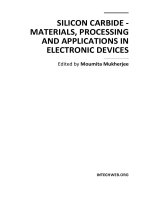Silicon Carbide Materials Processing and Applications in Electronic Devices Part 1 docx
Bạn đang xem bản rút gọn của tài liệu. Xem và tải ngay bản đầy đủ của tài liệu tại đây (3.63 MB, 35 trang )
SILICON CARBIDE -
MATERIALS, PROCESSING
AND APPLICATIONS IN
ELECTRONIC DEVICES
Edited by Moumita Mukherjee
Silicon Carbide - Materials, Processing and Applications in Electronic Devices
Edited by Moumita Mukherjee
Published by InTech
Janeza Trdine 9, 51000 Rijeka, Croatia
Copyright © 2011 InTech
All chapters are Open Access articles distributed under the Creative Commons
Non Commercial Share Alike Attribution 3.0 license, which permits to copy,
distribute, transmit, and adapt the work in any medium, so long as the original
work is properly cited. After this work has been published by InTech, authors
have the right to republish it, in whole or part, in any publication of which they
are the author, and to make other personal use of the work. Any republication,
referencing or personal use of the work must explicitly identify the original source.
Statements and opinions expressed in the chapters are these of the individual contributors
and not necessarily those of the editors or publisher. No responsibility is accepted
for the accuracy of information contained in the published articles. The publisher
assumes no responsibility for any damage or injury to persons or property arising out
of the use of any materials, instructions, methods or ideas contained in the book.
Publishing Process Manager Dragana Manestar
Technical Editor Teodora Smiljanic
Cover Designer Jan Hyrat
Image Copyright Only Fabrizio, 2011. Used under license from Shutterstock.com
First published September, 2011
Printed in Croatia
A free online edition of this book is available at www.intechopen.com
Additional hard copies can be obtained from
Silicon Carbide - Materials, Processing and Applications in Electronic Devices,
Edited by Moumita Mukherjee
p. cm.
978-953-307-968-4
free online editions of InTech
Books and Journals can be found at
www.intechopen.com
Contents
Preface IX
Part 1 Silicon Carbide: Theory, Crystal Growth, Defects,
Characterization, Surface and Interface Properties 1
Chapter 1 Mechanical Properties of Amorphous Silicon Carbide 3
Kun Xue, Li-Sha Niu and Hui-Ji Shi
Chapter 2 SiC Cage Like Based Materials 23
Patrice Mélinon
Chapter 3 Metastable Solvent Epitaxy of SiC,
the Other Diamond Synthetics 53
Shigeto R. Nishitani, Kensuke Togase,
Yosuke Yamamoto, Hiroyasu Fujiwara and
Tadaaki Kaneko
Chapter 4 The Formation of Silicon Carbide
in the SiC
x
Layers (x = 0.03–1.4)
Formed by Multiple Implantation of C Ions in Si 69
Kair Kh. Nussupov and Nurzhan B. Beisenkhanov
Chapter 5 SiC as Base of Composite
Materials for Thermal Management 115
J.M. Molina
Chapter 6 Bulk Growth and Characterization of SiC Single Crystal 141
Lina Ning and Xiaobo Hu
Chapter 7 SiC, from Amorphous to Nanosized Materials,
the Exemple of SiC Fibres Issued of Polymer Precursors 161
Philippe Colomban
Chapter 8 Micropipe Reactions in Bulk SiC Growth 187
M. Yu. Gutkin, T. S. Argunova,
V. G. Kohn, A. G. Sheinerman and J. H. Je
VI Contents
Chapter 9 Thermal Oxidation of Silicon Carbide (SiC) –
Experimentally Observed Facts 207
Sanjeev Kumar Gupta and Jamil Akhtar
Chapter 10 Creation of Ordered Layers on Semiconductor Surfaces:
An ab Initio Molecular Dynamics Study of the
SiC(001)-3×2 and SiC(100)-c(2×2) Surfaces 231
Yanli Zhang and Mark E. Tuckerman
Chapter 11 Optical Properties and Applications
of Silicon Carbide in Astrophysics 257
Karly M. Pitman, Angela K. Speck,
Anne M. Hofmeister and Adrian B. Corman
Chapter 12 Introducing Ohmic Contacts into
Silicon Carbide Technology 283
Zhongchang Wang, Susumu Tsukimoto,
Mitsuhiro Saito and Yuichi Ikuhara
Chapter 13 SiC-Based Composites Sintered
with High Pressure Method 309
Piotr Klimczyk
Part 2 Silicon Carbide:
Electronic Devices and Applications 335
Chapter 14 SiC Devices on Different Polytypes:
Prospects and Challenges 337
Moumita Mukherjee
Chapter 15 Recent Developments on Silicon Carbide
Thin Films for Piezoresistive Sensors Applications 369
Mariana Amorim Fraga, Rodrigo Sávio Pessoa,
Homero Santiago Maciel and Marcos Massi
Chapter 16 Opto-Electronic Study of SiC Polytypes: Simulation
with Semi-Empirical Tight-Binding Approach 389
Amel Laref and Slimane Laref
Chapter 17 Dielectrics for High Temperature
SiC Device Insulation: Review of
New Polymeric and Ceramic Materials 409
Sombel Diaham, Marie-Laure Locatelli and
Zarel Valdez-Nava
Chapter 18 Application of Silicon Carbide in
Abrasive Water Jet Machining 431
Ahsan Ali Khan and Mohammad Yeakub Ali
Contents VII
Chapter 19 Silicon Carbide Filled Polymer Composite for
Erosive Environment Application: A Comparative
Analysis of Experimental and FE Simulation Results 453
Sandhyarani Biswas, Amar Patnaik and Pradeep Kumar
Chapter 20 Comparative Assessment of
Si Schottky Diode Family in DC-DC Converter 469
Nor Zaihar Yahaya
Chapter 21 Compilation on Synthesis, Characterization and
Properties of Silicon and Boron Carbonitride Films 487
P. Hoffmann, N. Fainer, M. Kosinova, O. Baake and W. Ensinger
Preface
Silicon Carbide (SiC) and its polytypes have been a part of human civilization for a
long time; the technical interest of this hard and stable compound has been realized in
1885 and 1892 by Cowless and Acheson for grinding and cutting purpose, leading to its
manufacture on a large scale. The fundamental physical limitations of Si operation at
higher temperature and power are the strongest motivations for switching to wide
bandgap (WBG) semiconductors such as SiC for these applications. The high output
power density of WBG transistors allows the fabrication of smaller size devices with
the same output power. Higher impedance, due to the smaller size, allows easier and
lower loss matching in amplifiers. The operation at high voltage, due to its high
breakdown electric field, not only reduces the need for voltage conversion, but also
provides the potential to obtain high efficiency, which is a critical parameter for
amplifiers. The wide bandgap enables it to operate at elevated temperatures. These
attractive features in power amplifier enabled by the superior properties make these
devices promising candidates for microwave power applications. Especially military
systems such as electrically steered antennas (ESA) could benefit from more compact,
broadband and efficient power generation.
Another application area is robust front end electronics such as low noise amplifiers
(LNAs) and mixers. A higher value of saturation velocity in SiC will allow higher current
and hence higher power from the devices. Heat removal is a critical issue in microwave
power transistors. The thermal conductivity of SiC is substantially higher than that of
GaAs and Si. The large bandgap and high temperature stability of SiC and GaN also
makes them possible to operate devices at very high temperatures. At temperatures
above 300
0
C, SiC has much lower intrinsic carrier concentrations than Si and GaAs. This
implies that devices designed for high temperatures and powers should be fabricated
from WBG semiconductors, to avoid effects of thermally generated carriers. When the
ambient temperature is high, the thermal management to cool down crucial hot sections
introduces additional overhead that can have a negative impact relative to the desired
benefits when considering the overall system performance.
The potential of using SiC in semiconductor electronics has been already recognized
half a century ago. Despite its well-known properties, it has taken a few decades to
overcome the exceptional technological difficulties of getting SiC material to reach
device quality and travel the road from basic research to commercialization.
X Preface
SiC exists in a large number of cubic (C), hexagonal (H) and rhombohedral (R)
polytype structures. It varies in the literature between 150 and 250 different ones. For
microwave and high temperature applications the 4H is the most suitable and popular
polytype. Its carrier mobility is higher than in the 6H-SiC polytype, which is also
commercially available. SiC as a material is thus most suited for applications in which
high-temperature, high-power, and high-frequency devices are needed. To that end,
this book is a good compendium of advances made since the early 1990s at numerous
reputable international institutions by top authorities in the field.
Sequence of chapters is arranged to cover a wide array of activities in a fairly coherent
and effective manner. In 21 chapters of the book, special emphasis has been placed on
the “materials” aspects and developments thereof. To that end, about 70% of the book
addresses the theory, crystal growth, defects, surface and interface properties,
characterization, and processing issues pertaining to SiC. The remaining 30% of the
book covers the electronic device aspects of this material. Overall, this book will be
valuable as a reference for SiC researchers for years to come.
This book prestigiously covers our current understanding of SiC as a semiconductor
material in electronics. Its physical properties make it more promising for high-
powered devices than silicon. The volume is devoted to the material and covers
methods of epitaxial and bulk growth. Identification and characterization of defects is
discussed in detail. The contributions help the reader to develop a deeper
understanding of defects by combining theoretical and experimental approaches.
Apart from applications in power electronics, sensors, and NEMS, SiC has recently
gained new interest as a substrate material for the manufacture of controlled
graphene. SiC and graphene research is oriented towards end markets and has high
impact on areas of rapidly growing interest like electric vehicles.
Dr. Moumita Mukherjee,
Scientist-B, Senior Asst. Professor
Centre for Millimeter-wave Semiconductor Devices and Systems (CMSDS),
Institute of Radio Physics and Electronics,
University of Calcutta,
India
Part 1
Silicon Carbide: Theory, Crystal Growth,
Defects, Characterization, Surface and
Interface Properties
1
Mechanical Properties of Amorphous
Silicon Carbide
Kun Xue
1
, Li-Sha Niu
2
and Hui-Ji Shi
2
1
State Key Laboratory of Explosion Science and Technology,
Beijing Institute of Technology
2
School of Aerospace, FML, Department of Engineering Mechanics,
Tsinghua University, Beijing,
China
1. Introduction
Excellent physical and chemical properties make silicon carbide (SiC) a prominent candidate
for a variety of applications, including high-temperature, high-power, and high-frequency
and optoelectronic devices, structural component in fusion reactors, cladding material for
gas-cooled fission reactors, and an inert matrix for the transmutation of Pu(Katoh, Y. et al.,
2007; Snead, L. L. et al., 2007). Different poly-types of SiC such as 3C, 6H of which 6H have
been researched the most. There has been a considerable interest in fabricating 3C-SiC/6H-
SiC hetero p-n junction devices in recent years. Ion implantation is a critical technique to
selectively introduce dopants for production of Si-based devices, since conventional
methods, such as thermal diffusion of dopants, require extremely high temperatures for
application to SiC. There is, however, a great challenge with ion implantation because it
inevitably produces defects and lattice disorder, which not only deteriorate the transport
properties of electrons and holes, but also inhibit electrical activation of the implanted
dopants(Benyagoub, A., 2008; Bolse, W., 1999; Jiang, W. et al., 2009; Katoh, Y. et al., 2006).
Meanwhile the swelling and mechanical properties of SiC subjected to desplacive neutron
irradiation are of importance in nuclear applications. In such irradiations the most dramatic
material and microstructural changes occur during irradiation at low temperatures.
Specifically, at temperatures under 100˚C volumetric swelling due to point defect induced
strain has been seen to reach 3% for neutron irradiation doses of ~0.1-0.5. At these low
temperatures, amorphization of the SiC is also possible, which would lead to a substantial
volumetric expansion of ~15%, along with decreases in mechanical properties such as
hardness and modulus(Snead, L. L. et al., 1992; Snead, L. L. et al., 1998; Snead, L. L., 2004;
Weber, W. J. et al., 1998).
Intensive experimental and theoretical efforts have been devoted to the dose and
temperature dependence of the properties of irradiation-amorphized SiC (a-SiC)(Weber, W.
J. et al., 1997). Heera et al. (Heera, V. et al., 1997) found that the amorphization of SiC
induced by 2 MeV Si
+
implantation is accompanied by a dramatic and homogeneous volume
swelling until a critical dose level dependent on the temperature. Afterwards the volume
tends to saturate and the density of a-SiC is about 12% less than that of the crystalline
Silicon Carbide – Materials, Processing and Applications in Electronic Devices
4
material. The experimental values of the elastic modulus and hardness of a-SiC estimated
from measurements of surface and buried amorphous layers show a large degree of
variability. In general, the hardness and elastic modulus in a-SiC are observed to decrease
20%-60% and 25%-40%, respectively. Weber et al.(Weber, W. J. et al., 1998) performed
nanoindentation experiments with Berkovich indenter on the Ar
+
beam induced a-SiC. The
results suggest that the elastic modulus decreases ~24%, from 550 to 418 GPa. Snead et
al.(Snead, L. L. et al., 1992) reported that the elastic modulus in SiC, irradiated with C
+
at
low temperatures, decrease from 400 GPa in the virgin region to about 275 GPa in the
amorphized region; whereas the hardness was observed to decrease from 41 to 32 GPa. The
mechanical properties of a-SiC irradiated by neutron have also been investigated(Snead, L.
L. et al., 1998). A density decrease of 10.8% from the crystalline to amorphous (c-a) state is
revealed along with a decrease in hardness from 38.7 to 21.0 GPa and a decrease in elastic
modulus from 528 to 292 GPa.
The varying amorphous nature of a-SiC depending on the damage accumulation could
justify the wide range of experimental measurements of mechanical properties of a-SiC.
Thus of particular fundamental and technological interest has been developing the models
capable of describing the various physical properties of SiC as a function of microstructural
changes, specifically from c-a. Gao and Weber(Gao, F. & Weber, W. J., 2004) investigated the
changes in elastic constants, the bulk and elastic moduli of SiC as a function of damage
accumulation due to cascade overlap using molecular dynamics (MD) simulation. The
results indicate a rapid decrease of these properties with increasing dose but the changes
begin to saturate at doses greater than 0.1 MD-dpa. Given that fully amorphous state is
reached at a dose of about 0.28 MD-dpa, they suggested that point defects and small cluster
may contribute more significantly to the changes of elastic constants than the topological
disorder associated with amorphization.
Although the inherent correlation between the mechanical properties and the disordered
microstructures of a-SiC has been widely accepted, there still lacks a comprehensive
description of this correlation given the intricate nature of a-SiC. Thus based on detailed
examinations of an extensive series of simulated a-SiC models with varying concentration of
defects, this chapter first attempts to characterize the structure of a-SiC with a range of
underpinning parameters, whereby substantiates the correlation between the amorphous
structure of SiC and a variety of mechanical properties. MD simulations are used to simulate
the mechanical responses of varied disordered SiC microstructures subject to two typical
loadings, namely axial tension and nanoindentaion, which are critical for measures of
strength and ductility of bulk a-SiC and hardness of a-SiC film. The role of these simulations
is not necessarily to reproduce exact experimental behaviors, but rather to identify possible
atomistic mechanisms associated with a variety of disordered SiC structures, especially from
c-a.
Amorphous materials often exhibit unique deformation mechanisms distinct from their
crystalline counterparts. The coexistence of brittle grains and soft amorphous grain
boundaries (GBs) consisting in nanocrystalline SiC (nc-SiC) results in unusual deformation
mechanisms. In the simulation of nanoindentation(Szlufarska, I. et al., 2005), as the indenter
depth increases, the deformation dominated by the crystallization of disordered GBs which
“screen” the crystalline grains from deformation switches to the deformation dominated by
disordering of crystalline grains. Plastic flow along grain boundaries can also effectively
Mechanical Properties of Amorphous Silicon Carbide
5
suppresses the cavity nucleation, leading to increased ductility and toughness without
compromising its strength(Mo, Y. & Szlufarska, I., 2007).
Because amorphous materials lack a topologically ordered network, analysis of
deformations and defects presents a formidable challenge. Conventional computational
techniques used for crystalline solids, such as the modulus of slip vector(Rodriuez de la
Fuente, O. et al., 2002), centrosymmetry, and local crystalline order, fail to identify the
deformation defects in disordered materials. Various models have been proposed to
describe defects in such structures. The prevailing theory of plasticity in metallic glasses
involves localized flow events in shear transformation zones (STZ)(Shi, Y. & Falk, M. L.,
2005). An STZ is a small cluster of atoms that can rearranges under applied stress to produce
a unit of plastic deformation. It is worth noting that most of these theories are based on the
observations of metallic glasses. Whereas covalently bonded amorphous solids differs from
their metallic counterparts due to their directed stereochemical bonds in forms of well-
defined coordination polyhedral, e.g. [SiX4]or [CX4] tetrahedra in SiC. Thanks to the short
range order retained in the amorphous covalent materials, plastic deformation tends to be
more pronounced localized than in the case of metallic glasses(Szlufarska, I. et al., 2007).
Moreover for amorphous alloys like a-SiC, the degree of chemical order has been always
under the debates, although the consensus from these recent experimental studies of a-SiC
seems to be in favor of the existence of C-C homonuclear bonds(Bolse, W., 1998; Ishimaru,
M. et al., 2002; Ishimaru, M. et al., 2006; Snead, L. L. & Zinkle, S. J., 2002). The presence of
dual disorder, namely chemical and topological disorder, in a-SiC definitely complicates the
analysis of amorphous structure and the underlying atomic mechanisms.
In general a truly atomistic model of plastic flow in amorphous covalent materials is still
lacking. Instead of starting with complete a-SiC where widespread inhomogenities frozen
into the entire material, we rather begin with a perfect 3C-SiC, then proceed to gradually
increase the concentration of damage until a complete amorphous state is reached. Being a
link between perfect crystalline and complete amorphous SiC, partially disordered SiC
presents a favorable prototype to discern the role of isolated or clustered defects in the
evolution of atomic mechanism, where the deformation defects are comparatively readily to
identify.
In this chapter, we first outline the studies concerning the c-a transition of irradiation-
amorphized SiC, laying the basis for the analysis of SiC amorphous. Then a complete
topological description of simulated SiC structures ranging from c-a is presented in both the
short – and medium-range with a special focus on the correlation between chemical disorder
and the topology of a-SiC. Simulated tensile testing and nanoindentation are carried out on
the varying a-SiC to examine the variations of mechanical response with varying
concentration of defects. The correlation between some key mechanical properties of a-SiC,
such as Young’s modulus, strength, hardness, and the microstructure are quantified by
virtue of chemical disorder, an characteristics underpinning the c-a transition. A crossover
of atomic mechanisms from c-a are also discussed. This crossover is also embodied in the
switch of the fracture .
2. Amorphization mechanism of irradiation-amorphized SiC
With regard to the characterization of the varying disordered microstructures of a-SiC, the
mechanisms controlling the c-a transformation have been of particular interest. By
simulating the accumulation of irradiation damages due to the low energy recoils, Malerba
Silicon Carbide – Materials, Processing and Applications in Electronic Devices
6
and Perlado(Malerba, L. & Perlado, J. M., 2001) argued that both Frenkel pairs and antisite
defects play significant roles in the amorphization process and that the coalescence and
growth of defect clusters account for the amorphization of SiC. Antisite defects were found
to be less numerous than Frenkel defects, whose accumulation has been instead primarily
supposed to trigger amorphization. However Frenkel pairs have strong correlation with
antisites. The MD simulation of the disordering and amorphization processes in SiC
irradiated with Si and Au ions reveals much higher concentration of antisites in complete
amorphous areas where are supposed to comprise large amount of Frenkel pairs than other
disordered domains(Gao, F. & Weber, W. J., 2001). Furthermore where is significant overlap
of antisite coordination shells, where there are a significant number of Frenkel pairs that are
accommodated. If completely excluding antisites, Frenkel defects would become extremely
unstable, leading to difficulties of amorphization. Rong et al.(Rong, Z. et al., 2007) simulated
the recovery of point defects created by a single cascade during the thermo annealing via
dynamic lattice MD technique. The results suggest that a large number of irradiation
induced Frenkel pairs are formed in metastable configurations, and majority of close pairs
would recombine during the annealing at 200 K and 300 K. Contrasting with the dramatic
annihilation of Frenkel defects upon annealing, the number of antisite largely remains
constant even increases somewhat due to the recombination of interstitials from one
sublattice with vacancies on the other. Therefore the role of antisite in the amorphization of
SiC is of equal essence.
Basically both Frenkel and antisite defects could give rise to dual disorder, namely
topological and chemical disorder. Homonuclear bonds (C-C, Si-Si) are likely to form when
antisite or Frenkel defects are introduced, producing a certain degree of chemical disorder.
The homonuclear bond ratio R
hnb,
defined for SiC as the ratio of number of homonuclear
bonds to twice the number of heteronuclear bonds, provides a full homonuclear bond
analysis. Chemical disorder χ(Tersoff, J., 1994), defined as the ratio of C-C bonds to C-Si
bonds, N
C-C
/N
Si-C
, is not a full homonuclear bond analysis and is specified only for C atoms.
The argument for using χ instead of R
hnb
derives mostly from the practical uncertainty of
enumerating Si-Si bonds in amorphous structures for which Si atoms have no clearly
defined first coordination shell. In practice, χ is quite a good approximation to R
hnb
and the
deviation is proportional to the coordination number difference between Si and C.
The topological disorder of a-SiC manifests itself in variations of the short- and medium-
range. Short-range order (SRO), as its name implies, concerns structural order involving
nearest-neighbour coordination shell. This is easiest to discuss in the case of covalently
bonded amorphous solids since the presence of their directed stereochemical bonds
simplifies the description considerably. For example, in the case of SiC, SRD is defined in
terms of well defined local coordination tetrahedra. The parameters which are sufficient to
describe topological SRO in stereochemical systems are the (coordination) number, N
ij
, of
nearest neighbors of type j around an origin atom of type i, the nearest-neighbour bond
length R
ij
, the bond angle subtended at atom i, θ
jik
(when the atom of type k is different from
j). The connectivity of polyhedral dictates the type and extent of medium-range order
(MRO). Shortest-path ring(Rino, J. P. et al., 2004), defined as a shortest path consisting of
nearest-neighboring atoms, and local cluster primitive ring(Yuan, X. & Hobbs, L. W., 2002)
are among often used means to characterize the MRO. Because Frenkel pairs and anitisites
have overlapping effects on the amorphization of SiC, and exclusively focusing on the
formal Frenkel pairs and antisite configuration themselves has ignored the multiplier effects
Mechanical Properties of Amorphous Silicon Carbide
7
on the immediate coordination of a much larger number of atoms, hierarchical parameters
signifying SRO and MRO seem to be more appropriate to describe the c-a transition and
varying microstructures of a-SiC. The c-a transition is accordingly described in terms of the
variations in the chemical disorder χ and other topological parameters. The correlation
between them would be clarified in the next section.
3. Characterization of the structures of a-SiC
Considerable investigations, including experimental and MD simulation studies, indicate a
strong correlation between chemical and topological disorder. The x-ray absorption and
Ramann spectroscropy performed by Bolse(Bolse, W., 1998) on Na
+
irradiated SiC clearly
showed that a large fraction of the [SiC
4
] tetrahedra is destroyed only after the removal of
chemical order. The inspection of MD simulated melt-quenched a-SiC Has also revealed that
chemical disorder determines the short- and medium-range topological order in a-SiC(Xue,
K. et al., 2008). Therein an extended tetrahedron model only dependent on the composition
and chemical disorder χ was developed to predict the probabilities of various local
coordination tetrahedra, namely, Si-Si
4-n
C
n
and C-Si
4-n
C
n
(n = 0-4), reflecting the local spatial
distribution of homonuclear bonds.
(χ) C4 Si4 l
C-C
l
Si-C
l
Si-Si
Density (×10
3
Kg/m
3
)
Potential Energy
(eV/atom)
0.0 100. 100. N 1.896 N 3.217 -6.39279
0.045 99.9 99.6 1.662 1.862 2.185 3.213 -6.32738
0.133 99.5 98.9 1.661 1.867 2.191 3.148 -6.21825
0.24 98.4 97.8 1.648 1.872 2.225 3.087 -6.10155
0.39 96.1 95.1 1.646 1.877 2.258 3.063 -5.99751
0.422 96.3 92.1 1.635 1.880 2.28 3.058 -5.9726
0.54 96.2 84.1 1.610 1.885 2.337 3.053 -5.88191
0.7 94.2 83.5 1.585 1.904 2.379 3.049 -5.81427
Table 1. Structural characteristics and potential energies of chemical disordered SiC with
varying χ. Notations: X4 (X = C or Si), the percentage of four-fold coordinated X atoms; l
X-Y
(X, Y = C or Si), the average bond length of X-Y bond. In our calculations the cut-off
distances of the C-C, Si-C, and C-C interactions are 1.75 Å, 2.0 Å and 2.5 Å, respectively.
The inspection of MD simulated irradiation-induced a-SiC has investigated the changes of
topological order as a function of chemical disorder and suggested that some threshold
chemical disorder should be one requirement for amorphization(Xue, K. & Niu, L S., 2009;
Yuan, X. & Hobbs, L. W., 2002). Herein interatomic interactions were modeled using the
1994 Tersoff potential improved by Tang and Yip(Tang, M. & Yip, S., 1995; Tersoff, J., 1994).
Devanathan et al.(Devanathan, R. et al., 2007) compared the structures of modeled melt-
quenched a-SiC obtained from three different potentials, namely Tersoff, Brenner, and ionic
potentials, with the results of a tight-binding MD (TBMD) simulation and an ab initio study.
They found that the structural features of a-SiC given by Tersoff potential appear to be in
better agreement with ab initio and TBMD results. In order to explore the role of chemical
disorder in the changes of SiC topology, varying chemical disorder ranging from 0 to 0.7 are
imposed on a set of 3C-SiC perfect crystal models by swapping pairs of random sites.
Silicon Carbide – Materials, Processing and Applications in Electronic Devices
8
The SRO and MRO of all SiC assemblies with varying imposed chemical disorder are
examined in terms of a variety of parameters, such as coordination number, pair correlation
functions g
αβ
(r) and local cluster primitive ring statistics. Table 1 summaries the variations of
some important SRO indicators of a-SiC with varying χ. The number of four-fold
coordinated C and Si atoms declines with increasing χ especially for the case of Si atom,
which is in accordance with the argument in Sec. 2 that more interstitials (vacancies) are
accommodated in the areas abundant in antisites. Another feature worth noting is the
significant lengthening of C-C bond and the shortening of Si-Si and Si-C bonds, the trend
being more pronounced for small χ.
The two body structural correlations of the amorphous materials are analyzed by pair
correlations functions g
αβ
(r). The evolution of MRO can be traced in terms of the local cluster
primitive (LC) ring content, defined as a closed circuit passing through a given atom of the
network which cannot be decomposed into two smaller circuits. The LCs haven been shown
to uniquely characterize the topologies of all compact crystalline silica, Si
3
N
4
and SiC
polymorphs(Hobbs, L. W. et al., 1999). In the case of crystalline α- or β-SiC, the LCs
comprises 12 6-rings (as in Si).
Fig. 1. (a) Total pair correlation function g
αβ
(r) and (b) distribution of local cluster ring number
at Si sites for a-SiC samples with varying chemical disorder(Xue, K. & Niu, L S., 2009).
Fig. 1(a) shows the g
αβ
(r) for the SiC assemblies with increasing χ. The C-Si peak
substantially declines as χ increases accompanying the enhancement of the C-C and Si-Si
peaks. Any appreciable changes of g
αβ
(r) could barely be identified after χ ~ 0.5, in a sense
meaning the saturation of short-range disordering. Fig. 1(b) demonstrates that the majority
of the LCs for χ < 0.24 consist of 12 6-SiC as in 3C-SiC, significant changes of LCs contents
occur within the range of 0.24 < χ < 0.54, and afterwards the changes tend to saturate. The
chemical disorder dependences of SRO and MRO depict the same picture: perfect
topological order in 3C-SiC structure is energetically stable until chemical disorder reaches
beyond the χ = 0.24 – 0.42 range; for χ ≥ 0.54, topological perfection appears impossible to
maintain and a stable amorphous structure is achieved.
4. Tensile testing simulation of a-SiC
4.1 Variations in elastic properties of SiC from crystalline to amorphous
Gao and Weber(Gao, F. & Weber, W. J., 2004) calculated the changes of elastic constants, C
11
,
C
12
, C
44
, the bulk modulus, B, and averaged elastic modulus, E as a function of dose for
cascade-amorphized SiC by imposing moderate strain (<1%) along the MD cell axes. All
Mechanical Properties of Amorphous Silicon Carbide
9
elastic constants and elastic modulus show expected softening behavior under irradiation
for the dose range of interest. Fig. 2 shows their typical results with regard to the variations
of elastic modulus, E and bulk modulus B. These elastic properties decrease rapidly at doses
less than 0.1 MD-dpa, and the decrease becomes smaller at the high dose levels. On account
of the dose dependence of the formation and coalescence of point defects and small clusters,
they concluded that point defects and small clusters contribute much greater than
topological disorder to the degradation of elastic properties of a-SiC.
Fig. 2. variation of elastic modulus, E, and bulk modulus, B, as a function of dose(Rino, J. P.
et al., 2004)
4.2 Tensile mechanical response of a-SiC
Point defects, small clusters and topological disorder as forms of defect accumulation could
somehow indicate the dependence of mechanical properties of a-SiC on the disordered
microstructure. However it is difficult to enumerate these damages due to the ambiguous
definitions of their complicated configurations. Bearing in mind that chemical disorder χ is
of essence to trigger the c-a transition as elucidated in Sec.3, chemical disorder χ is able to
distinguish varying disordered SiC structures. Thus formulating the correlation between a
variety of mechanical properties and chemical disorder χ provide a favorable alternative to
quantify the microstructure dependence of mechanical properties.
(a) (b)
Fig. 3. (a) stress vs strain curves for a-SiC samples with varying chemical disorder at a strain
rate of 10
8
s
-1
(Xue, K. & Niu, L S., 2009); (b) stress vs strain curves for 3C-SiC, nc-SiC and
melt-quenched a-SiC with an extension rate of 100 m/s(Ivashchenko, V. I. et al., 2007)
Silicon Carbide – Materials, Processing and Applications in Electronic Devices
10
Simulated axial tensile testing is carried out on a set of SiC assemblies with varying chemical
disorder χ, representing a range of disordered structures from crystalline to complete
amorphous. The full stress-strain dependences for different SiC assemblies with varying χ are
shown in Fig. 3. The stress-strain curve for 3C-SiC features a linear elastic stage ending up with
an abrupt drop of the stress, while the presence of negligible chemical disorder χ (χ=0.045) gives
rise to a noticeable deviation beyond ε ≈ 0.13 from what would be expected from extrapolation of
the linear elastic region. Meanwhile an appreciable softening of the material after the stress
reaches σ
max
can be observed, evidenced by the weak decrease of the stress before the rupture.
This plasticlike behavior becomes increasingly evident with increasing χ, pronounced plastic
flow plateau covering a major part of the whole mechanical response. Such plasticelike behavior
is reproduced in the tension of simulated melt-quenched a-SiC with a drastic reduction in the
number of tetrahedrally coordinated atoms(Ivashchenko, V. I. et al., 2007).
4.3 Mechanical properties of a-SiC as a function of chemical disorder χ
The chemical disorder dependence of the mechanical response of a-SiC is likewise embodied
in the variations of the Young’s modulus and strength of a-SiC with varying chemical
disorder [Fig. 4]. Young’s modulus and strength generally exhibit monotonic decrease with
increasing χ while in distinct manners until χ reaches 0.54, afterwards tend to saturate
regardless of the further increase of χ. Young’s modulus E
Y
shows negative linear
dependence on χ within the range of 0 < χ < 0.54 as follows:
00
0.9994 0.316
YY Y
EE E=−×
χ
× (1)
where E
Y0
is Young’s modulus along the [100] direction of 3C-SiC (~413 GPa). Young’s
modulus of complete a-SiC is around ~321.4 GPa, agreeing well with the value calculated
for the melt-quenched a-SiC which stands at ~327 GPa(Ivashchenko, V. I. et al., 2007). In
contrast with the consistent reduction of E
Y
with increasing χ before χ < 0.54, a dramatic
decrease of 23.2% for strength occurs at χ = 0.045, decreasing from ~90.8 GPa (χ = 0) to ~69.7
GPa (χ = 0.045). Whereas strength almost linearly declines afterwards with increasing χ as
the following relation until χ =0.54,
00
0.745 0.328SS S=−×
χ
× (2)
where S
0
is the strength of 3C-SiC (~90.8 GPa). When χ is beyond 0.54, a complete amorphous
state is reached, Young’s modulus and strength tend to be constant, which is in line with the
saturation of Elastic moduli of a-SiC at high doses(Gao, F. & Weber, W. J., 2004).
Fig. 4. Variations of Young’s modulus and strength as a function of chemical disorder(Xue,
K. & Niu, L S., 2009)
Mechanical Properties of Amorphous Silicon Carbide
11
4.4 Deformation mechanims
In order to gain further insights into the chemical disorder dependece of Young’s modulus
and strength, the knowledge of the deformation mechanims of varying disordered
structures is necessary. Young’s modulus of the covalent network is closely related with the
ability of the topological network to homogeneously elastic deform to accomadate the small
strain. Despite of the presence of moderate chemical disorder χ, the almost intact conection
of fundamental tetrahedral units, as well as their relative orientation, ensure the
homogeneously collective deformation of these units at small χ. Thus no appreciable
decrease of Young’s modulus could be detected for the SiC assembly with χ = 0.045. As χ
increases, the topological order gradually decays, resulting in the reduced stiffness of the
network and The ensuing decrease of Young’s modulus until a complete amorphous state is
reached. Actually the linear elastic region of mechanical response of a-SiC gradually
diminishes with the increasing χ.
Although a handfull of homonuclear bonds introduced by a negligeable chemcial disorder
(χ = 0.045) barely affect the topological order and the Young’s modulus, they account for a
substantial decline of strength. Due to the atom size difference, the C-C bonds in the
undeformed system have been stretched with a bond length increase of ~7% contrasting to
the contraction of Si-C and Si-Si bonds. With the strain processes, these stretched C-C bonds
are expected to break prior Si-C and Si-Si bonds. The premature breakage of C-C bonds
disconnects the neighboring tetrahedral network where the stress builds up. More
decohesions of atomic bonds therein conversely take place due to the localized stress. As a
results, Localized softened clusters around the initial chemical disorderd sites are formed,
where atomic rearrangements dominate the confined plastic flow. Fig. 5 (a) illustrates the
atomic slipping occurring in these softened regions. With the inceased χ, the enhanced
topological disorder gives rise to the prevalence of softening regions. Thus the localized
plastic flow evolves into percolating flow through the entire system [Fig. 5(b)].
Fig. 5. Atomic configurations for (a) the χ = 0.045 and (b) the χ = 0.39 assemblies at ε = 0.27.
Atoms are colored according to their motion relative to the homogeneous deformation. Blue
atoms have moved towards right relative to what would be expected if the deformation had
been homogeneous and elastic; red atoms have moved towards left. The scale indicates how
the atoms have moved (in angstroms)(Xue, K. & Niu, L S., 2009).
Silicon Carbide – Materials, Processing and Applications in Electronic Devices
12
4.5 Fracture modes
When the disorder SiC undergoes c-a transition with the increasing chemical disorder χ, the
main deformation mechanism evolves from elastic deformation to localized atomic
rearrangement, and then to percolating plastic flow. This crossover is also manifested itself
in the switch of the fracture mechanism. At a slight chemical disorder (χ =0.045), localized
softened clusters are embedded in the rigid topological ordered lattice which strongly
supresses the nucleation of nanocavities inside the disordered clusters. Thus the failure of
ligaments between softened clusters rather than the percolation of nanocavities leads to the
final brittle fracture, which is supported by the sudden drop of cavity density at ε ~0.3
[Fig.6]. Increased chemical disorder substantially alters the atomistic picture of fracture
mechanisms. In the fully amorphous system (χ = 0.54), extensive plastic flow nucleates a
large number of nanocavites, their coalescence and percolation through the system leading
to the final fracture. This argument is consistent with the slow decline of cavity desity after ε
~0.23 for the χ = 0.54 assembly [Fig. 6]. For a-SiC with moderate chemical disorder (0 < χ <
0.54), we can expect a competition of brittle and ductile fracture mechanism, dominated by
lattice instability and coalescence of nanocavities, respectively.
0.00 0.05 0.10 0.15 0.20 0.25 0.30 0.35
0.0
0.2
0.4
0.6
0.8
1.0
1.2
1.4
1.6
1.8
χ
= 0.045
χ
= 0.39
Cavity density (1/nm
3
)
Strain
χ
= 0.54
Fig. 6. Cavity densities as a function of strain (a) for different a-SiC samples with varying
chemical disorder at a strain rate of 10
8
s
-1
and (b) for the χ = 0.54 ensemble at different strain
rates(Xue, K. & Niu, L S., 2009).
Recently special efforts have been made to reveal the possible crossover of fracture modes
during c-a transition. Glassy materials are considered up to now as the archetype of pure
brittle materials, the brittle fracture of which proceeds solely by decohesion of atomic bonds
at the crack tip. However, AFM and high scanning electron microscopy (SEM) studies have
generated considerable controversy about the nature of fracture mechanism in brittle
amorphous solids(Celarie, F. et al., 2003). Xi et al.(Xi, X. K. et al., 2005) found a dimple
structure at the fracture surface of Mg-based bulk metallic glass by high resolution SEM,
indicating that the fracture in brittle metallic glassy materials might also proceed through
the softening mechanism but at nanometer scale. Chen et al.(Chen, Y C. et al., 2007) further
investigates the interaction of voids in silica glass by means of multimillion-to-billion-atom
MD simulation, unveiling the mechanism of nanocavities nucleation. These findings are in
line with the ductile fracture observed in a-SiC with χ ≥ 0.54 mediated by coalescence of
cavities similar to metal materials, although taking place at different length scales.
Mechanical Properties of Amorphous Silicon Carbide
13
5. Nanoindentation simulations of a-SiC
5.1 P-h curves of a-SiC
Nanoindentation is a widely used technique for probing mechanical properties and stability,
especially of surfaces and thin films. From the shape of load-indenter displacement (P-h)
curves, one can extract information about elastic moduli or hardness. Atomistic computer
simulations have been found very helpful in unraveling the processes underlying the
nanoindentation responses. For example, MD simulations of indentation of 3C-SiC have
shown that the p-h curve [Fig.7(b)] is correlated with the nucleation and coalescence of
dislocations under an indenter(Szlufarska, I. et al., 2005).
Amorphous materials lack a long-range order of topological network and hence there is no
clear notion of dislocations. Thus understanding atomistic processes during
nanoindentation in amorphous materials presents a great challenge. A few atomistic
simulations have been performed to tackle this problem. Szlufarska et al.(Szlufarska, I. et al.,
2007) undertook the difficult task of simulating nanoindentation of melt-quenched a-SiC
with a diamond indenter. The simulation reveals a noticeable localization of damage in the
vicinity of the indenter, however the localization is less pronounced than in the case of 3C-
SiC. As shown in Fig. 7(a), the P-h curve for a-SiC exhibits irregular, discrete load drops
similar to 3C-SiC [Fig. 7(b)]. Here, the load drops correspond to braking of the local
arrangements of atoms, in analogy to the slipping of atomic layers in 3C-SiC. Simulations
also show that, even at indentation depth h smaller than those at which the material yields
plastically, the material’s response is not entirely elastic. Instead, the amorphous structure,
which is metastable by nature, supports a small inelastic flow related to relaxation of atoms
through short migration distances.
Fig. 7. Load-displacement (P-h) responses for (a) a-SiC and (b) 3C-SiC(Szlufarska, I. et al.,
2007)
As aforementioned imposing increasing chemical disorder χ on 3C-SiC is able to produce a
series of disordered SiC structures ranging from perfect crystalline to complete amorphous,
providing favorable prototypes to observe the dependence of hardness on the damage
accumulation. More importantly, this means could allow us to identify possible atomistic
mechanisms in the early stages of plastic deformation as a function of microstructure. A set
of disordered SiC assemblies with varying chemical disorder χ are established as the
substrates in the means introduced in Sec.2. The Geometrical setup of the indenter and the
substrate is detailed in ref(Xue, K. & Niu, L S., 2010). In the case of 3C-SiC, the x, y, z
directions correspond to the
[110] ,[001] and[110] crystallographic directions, respectively.









